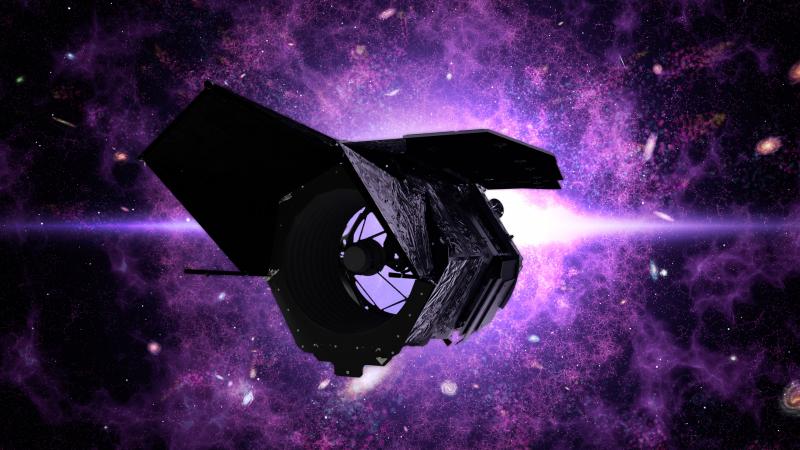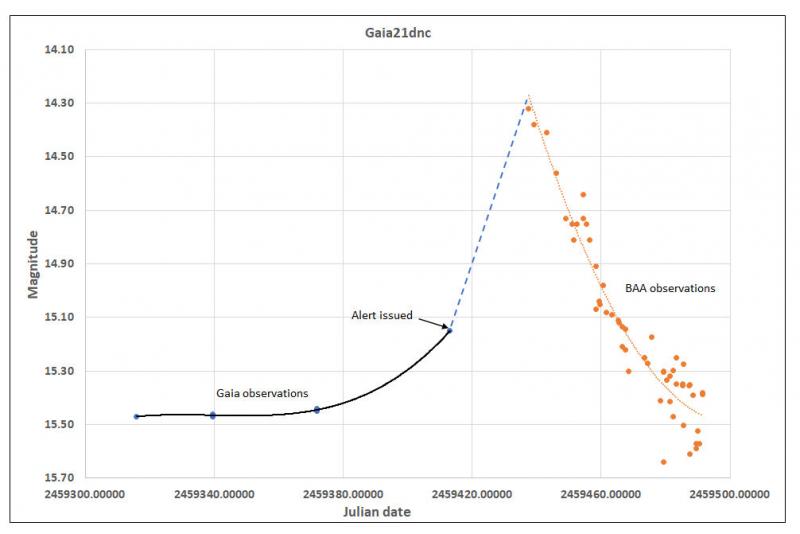Microlensing search for exoplanets – a new pro-am project
2021 November 30
The microlensing programme of the Asteroids & Remote Planets Section’s Exoplanet Division is in its early stages and is still very much in development, so your involvement would be most welcome. The required frequency of observations is typically every two to three hours and there are likely to be just a handful of targets available at any one time, so it should quite easily fit with any other observing programme you may be following.
Its advantage over comet and supernova hunting is that we know where to look. Now that the nights are longer, you have more opportunities to participate.
What is gravitational microlensing?
Gravitational microlensing is an observational effect that was predicted in 1936 by Albert Einstein, using his General Theory of Relativity. When one star (the lens) appears to pass in front of another (the source), the light rays of the background star become bent due to the gravitational attraction of the foreground star. The latter acts then as a virtual magnifying glass, amplifying the brightness of the source star. If the lens star harbours a planetary system, then those planets can also act as lenses, each one producing a slight deviation in the brightness of the source (see Figure 1).

As of 2021 Nov 13, 162 planets have been discovered from the ground using this technique. The Nancy Grace Roman Space Telescope (Figure 2) microlensing survey will detect many more such planets,1 including smaller-mass bodies that are greater than 1/10th the mass of Earth, since the ‘spike’ that the planet produces in the light curve is far more likely to be observed from a space-based platform. The results from this telescope’s microlensing survey will complement the exoplanet statistics from Kepler, and will provide answers to questions about planet formation, evolution and the prevalence of planets in the galaxy. The ‘Microlensing Source’ website is an excellent resource centre for all aspects of gravitational microlensing.2

Gaia
The Institute of Astronomy at the University of Cambridge searches for transient events in data from the Gaia space observatory and lists them on the ‘Index to Gaia photometric alerts’ web page. The Warsaw University Observatory’s Black Hole Target Observation Manager (BHTOM) and Las Cumbres Observatory’s Microlensing Observing Platform (MOP) both list potential microlensing targets,3,4 and it is from the former that alerts are generated for this project.
Figure 3 shows a typical microlensing light curve (from Bond, 2017),5 with deviation due to the presence of a planet shown in the inset.
![Figure 3. Light curve of OGLE–2016–BLG–1195Lb, taken from Bond (2017) [ref.4]. The inset shows the deviation due to the presence of a planet. Figure 3. Light curve of OGLE–2016–BLG–1195Lb, taken from Bond (2017) [ref.4]. The inset shows the deviation due to the presence of a planet.](https://britastro.org/wp-content/uploads/2021/11/fig3.png)
Guide for observers
This project should be well within the capabilities of observers familiar with making photometric measurements of, for example, asteroids, novae, supernovae or variable stars. As mentioned previously, the demands on observing time are minimal and should easily fit in with any other observing programmes. All you require is a telescope/CCD set-up that can measure magnitudes brighter than 18.
As is the norm for photometric imaging projects, there has been some discussion as to the use of filters. The current advice, to obtain the best approximation to Gaia magnitudes and merge magnitude measurements with pre-existing light curves, is as follows:
- For filtered imaging: Use a Sloan rʹ filter or use a Cousins R filter but ensure target is above 20 degrees in altitude.
- For unfiltered imaging: Ensure target is above 45 degrees in altitude and use Gaia DR2 data (bit.ly/3n9LQOu) for obtaining magnitudes of comparison stars.
An Asteroids & Remote Planets Section workshop to discuss the use of the aperture photometry tool and merging of observations using different filters will be held in early 2022.
Figure 4 shows a brightening detected by the Gaia satellite, which triggered an alert and subsequent observations by BAA members. The scatter is due to different filters being used and the presence of a bright Moon. Unfortunately, in this instance, no exoplanet was detected, but future observations may do so and help professional astronomers define the parameters of both the host star and orbiting planet.

Alerts are issued at regular intervals and take the form shown below.6
Target: Gaia21bfr
Region: northern hemisphere, southern hemisphere
RA 18:46:08.3, Dec –10:12:26
Last Gaia magnitude: 15.14
Time between observations: 1.0 days
Gaia alerts link (includes data and finder chart):7 bit.ly/2YHtHhR
Please send observation data to Roger Dymock (roger.dymock@ntlworld.com), who will upload it to the University of Warsaw’s BHTOM website. The data required are: observing site, observer name, photometric software, photometric catalogue used, catalogue magnitude band, date and time (JD; e.g. 59403.391447), target (e.g. Gaia21bfr), filter used, magnitude and error.
Roger Dymock, Asteroids & Remote Planets Section Assistant Director, Exoplanets
Links & references
- Nancy Grace Roman Space Telescope: roman.gsfc.nasa.gov/
- Microlensing Source: microlensing-source.org/
- BHTOM: bh-tom.astrolabs.pl/
- Las Cumbres Observatory’s Microlensing Observing Platform: mop.lco.global/
- Bond I. A., ‘The lowest mass ratio planetary microlens: OGLE–2016–blg–1195Lb’, Mon. Not. R. Astron. Soc., 469(2), 2434–2440 (2017)
- Exoplanet Division project: britastro.org/node/25935
- Index to Gaia photometric alerts: gsaweb.ast.cam.ac.uk/alerts/alertsindex
| The British Astronomical Association supports amateur astronomers around the UK and the rest of the world. Find out more about the BAA or join us. |
